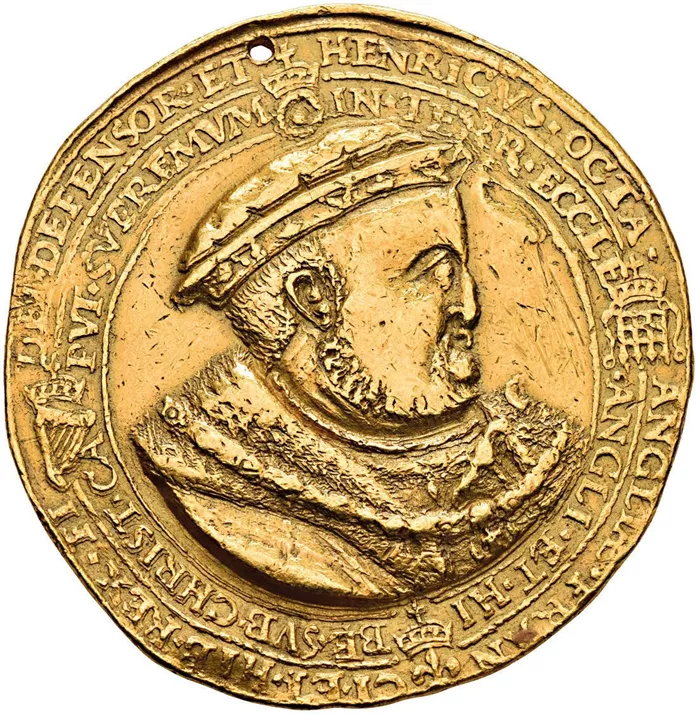The first British Proclamation Medal, perhaps unique in gold.
In the arcane world of Rare Coins and Medals there are a few different types of measures of rarity.
First there is the comparable rarity of different markets.
For example in the US silver dollar marekt the 1893 S Morgan silver dollar is considered quite rare as "only" 100,000 were minted that year.
An ancient coin that existed in that quantity would be considered extraordinarily common.
An ancient coin would be considered to be a rare coin if perhaps less than 20 were known on the market.
A commemorative gold medal might be rare if only a couple of hundred were minted several hundred years ago. But for many issues only a handful (say less than 10) exist.
At the same time, you often see a supposedly rare issue appear at auction several times in a single year. That is most often because A) a collection formed over many years, that has a few examples of the same coin or medal, hits the market, and is dispersed between a few different dealers or auction houses. And B) a coin or medal becomes suddenly very sought after and those who have been holding these for years decide to cash in on the craze all at once.
This can create the illusion that something that is actually exteremely rare is quite available. But in a year or two, if it is really rare, it disappears again from the market.
On the other hand a coin or medal that is not very rare may become the object of a collecting craze and it disappears from the market for a time through hoarding, Inevitably hoarders will at some point be forced to sell by broader financial conditions and a new market equilibrium will occur.
So know your market in order to understand when the term "rare" is tossed about.
The second factor in rarity is condition. This is the easiest to gauge because these days most coins and medals are graded, and the grading companies put out guides to how many coins exist in each grade.
So a common coin, that exists in a very high grade might be a "condition rarity."
These are the parameters of rarity. But then we move into the factors or rarity that make a coin or medal truely valuable:
1) Style. Excellent style is rare. Not every engraver is equally talented. And though some grading companies do try to account for style, ultimately you will need to rely on your own eye. But rest assured, value over time accrues to coins and medals of the finest style - precisely because true fine style is very rare.
An ancient coin of truly excellent style is very rare indeed. And because an eye capable of appreciating truly excellent style is rare, there are still tremendous oportunities to collect coins of beauty while others chase coins of a high technical grade. Over time, more and more coins will achieve high grades. But an ugly coin (As Churchill once quipped) will still be ugly in the morning. And a beautiful coin, will garner appreciation over the years.
Medals often tend to be of much finer style than coins. Because precious metal itself has been somewhat devalued since the gold window was closed by Nixon in 1971 - coins began to trade for a premium over medals. But now that financialization is in its descending phase, medals, especially in gold are begining to assume the place they have historically held in top cabinets, partly because of their stylistic superiority.
2. Historical Import. An event or personage of true historical import is rare. A coin or medal that commemorates that person or event will have added value because of that rarity. Coins and medallions pertaining to universally celebrated figures like Julius Caesar or Alexander the Great or Napoleon - or Jesus Christ, are obviously highly sought after. Medals commemorating milestones of admired rulers both Royal and Military (Coronations and Peace Treatys for example) tend to be quite rare and benefit from that rarity. Cerrtain personages or events are important to people in the regions where they lived and occured - and are avidly collected there - but not so much other places.
And First Issues tend to benefit from their hisorical import - especially in fine condition, The first staters of Kroisos. The earlist Athenian Owls. The earliest Electrum Staters. The first Renaissance Medallions. The first European Gold Medals. These all benefit from the rarity of their historical importance.
There is plenty of room within these parameters of rarity to find an area that appeals to you.
Particular issues of coins and medals go in and out of fashion. But if you find a beautiful, historically interesting and rare object, that is relatively out of fashion - that is something to seize upon.

No comments:
Post a Comment